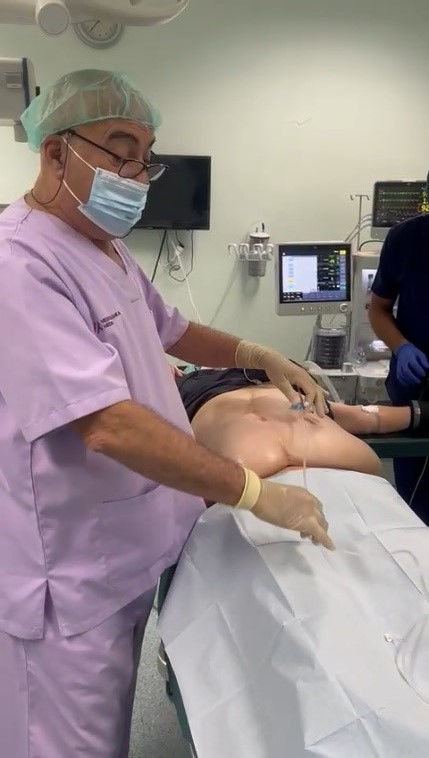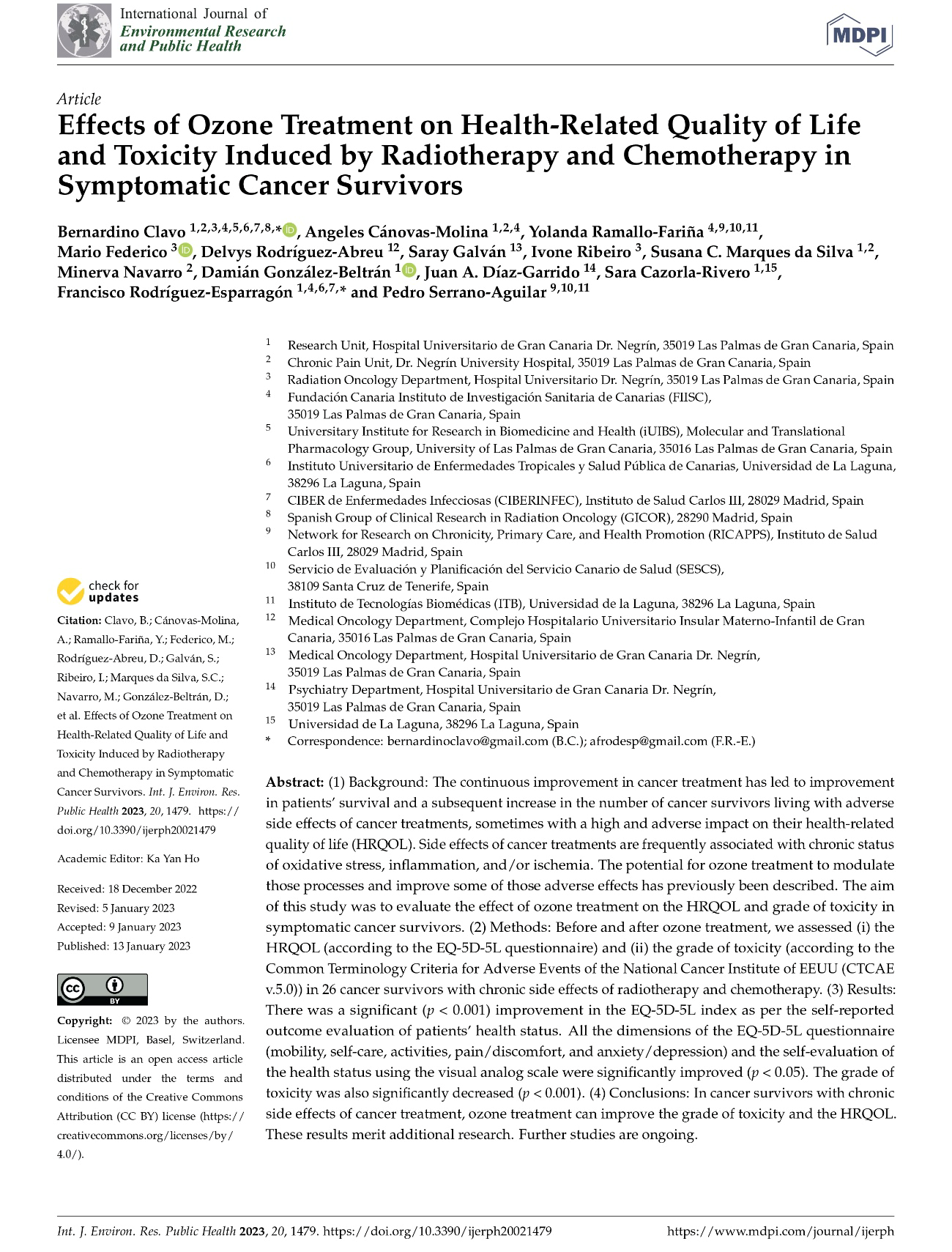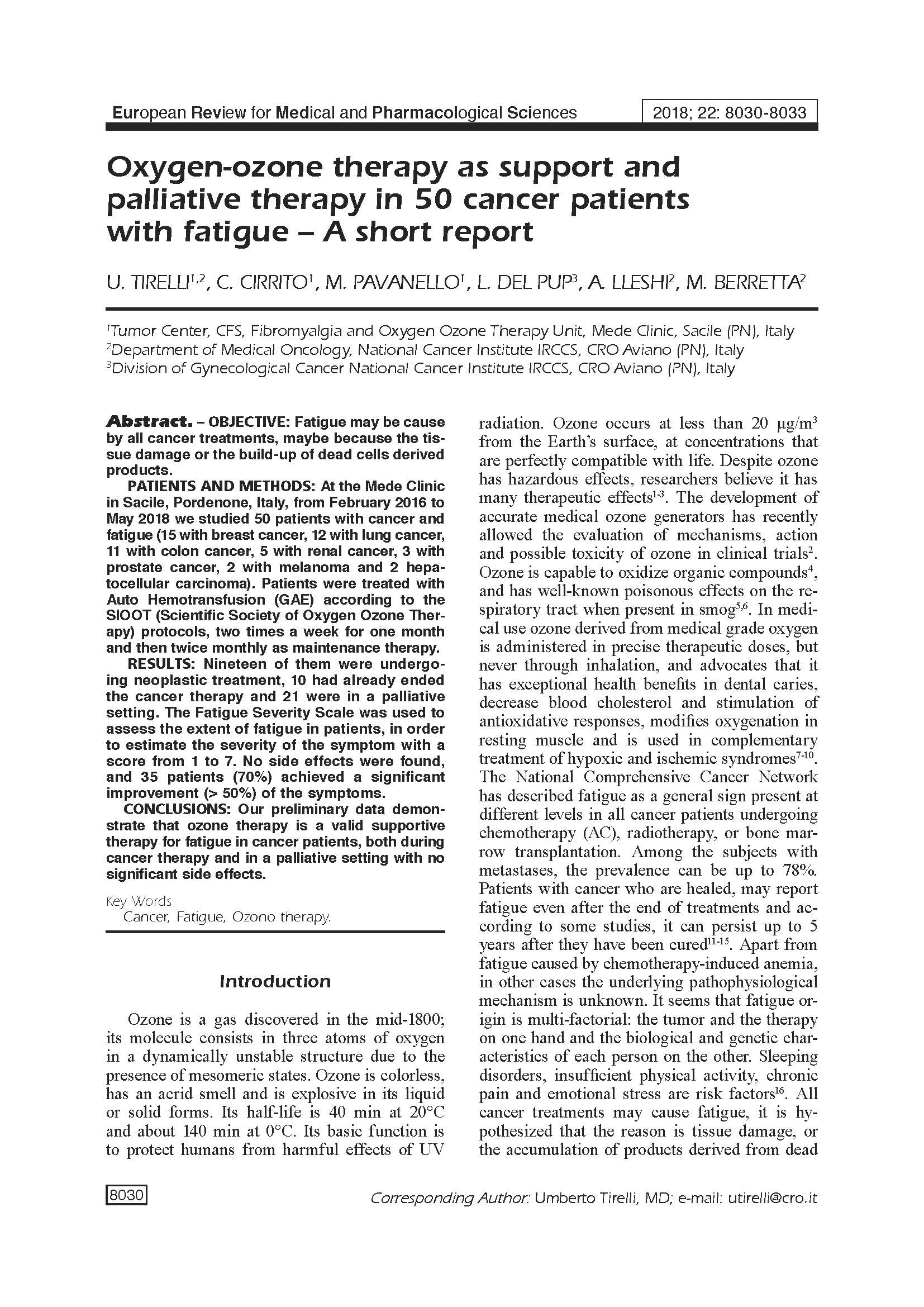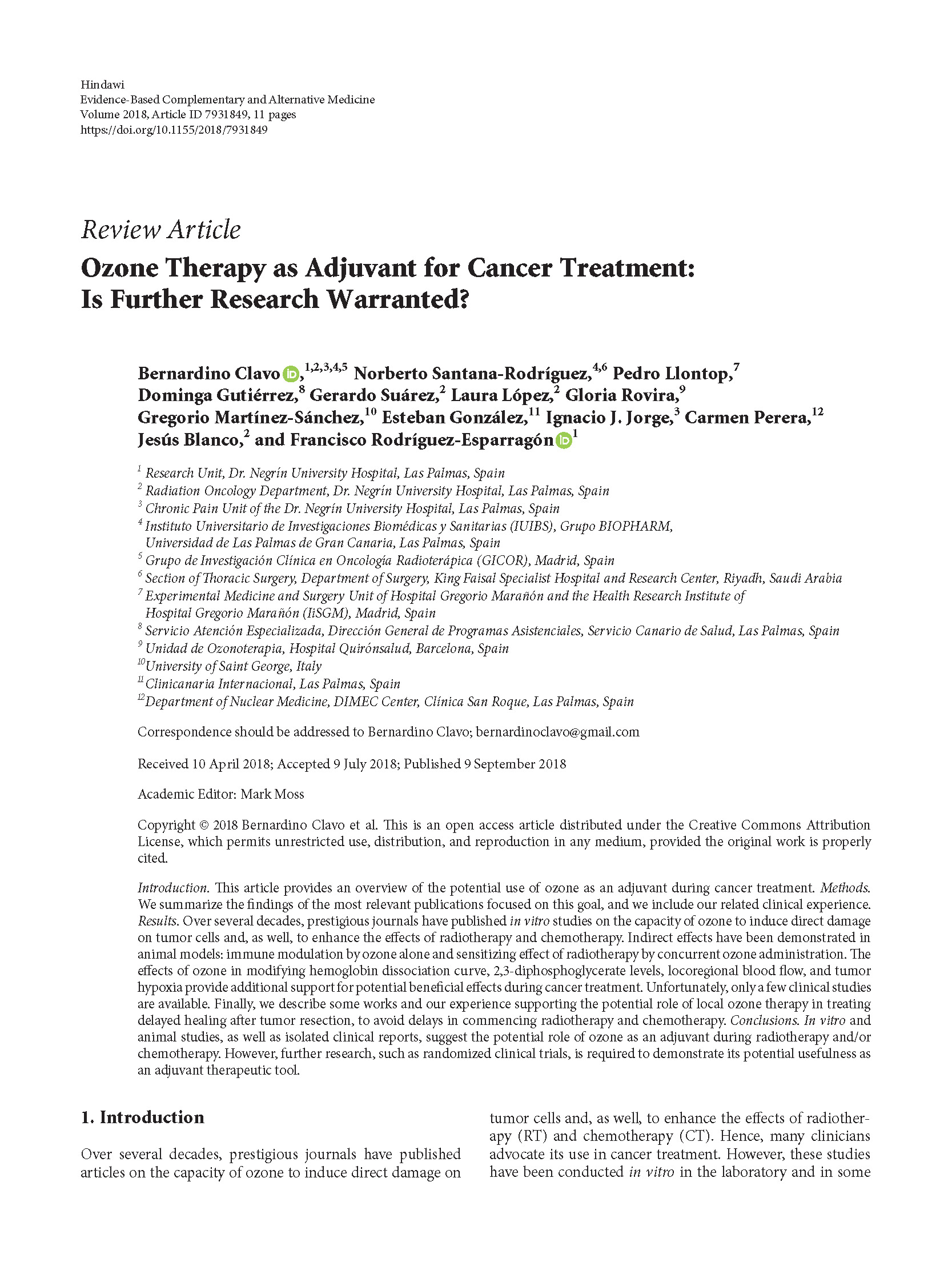BIBLIOGRAPHY
1. Li Y, Pu R. Ozone Therapy for Breast Cancer: An Integrative Literature Review. Integr Cancer Ther. 2024 Jan-Dec;23:15347354241226667. doi:10.1177/15347354241226667. PMID: 38258533; PMCID: PMC10807353.
2. Guo H, Liu J, Wei J. Ambient Ozone, PM1 and Female Lung Cancer Incidence in 436 Chinese Counties. Int J Environ Res Public Health. 2021 Oct2;18(19):10386. doi: 10.3390/ijerph181910386. PMID: 34639686; PMCID: PMC8508222.
3. Tirelli U, Valdenassi L, Franzini M, Pandolfi S, Fisichella R, Chirumbolo S.Oxygen-ozone autohemotherapy in breast cancer patients suffering from fatigue and musculoskeletal pain upon aromatase inhibitors treatment: a case-series study. Eur Rev Med Pharmacol Sci. 2023 Dec;27(23):11643-11652. doi: 10.26355/eurrev_202312_34602. PMID: 38095411.
4. Guo J, Guo J, Cheng B, Gong M, Sun X, Zhang H, Ma J. Ozone enhances the efficacy of radiation therapy in esophageal cancer. J Radiat Res. 2024 Jul 22;65(4):467-473. doi: 10.1093/jrr/rrae041. PMID: 38842109; PMCID: PMC11262864.
5. Clavo B, Navarro M, Federico M, Borrelli E, Jorge IJ, Ribeiro I, Rodríguez- Melcon JI, Caramés MA, Santana-Rodríguez N, Rodríguez-Esparragón F. Ozone Therapy in Refractory Pelvic Pain Syndromes Secondary to Cancer Treatment: A New Approach Warranting Exploration. J Palliat Med. 2021 Jan;24(1):97-102. doi: 10.1089/jpm.2019.0597. Epub 2020 May 5. PMID: 32379556.
6. Sweet F, Kao MS, Lee SC, Hagar WL, Sweet WE. Ozone selectively inhibits growth of human cancer cells. Science. 1980 Aug 22;209(4459):931-3. doi: 10.1126/science.7403859. PMID: 7403859.
7. Tirelli U, Cirrito C, Pavanello M, Del Pup L, Lleshi A, Berretta M. Oxygen- ozone therapy as support and palliative therapy in 50 cancer patients with fatigue - A short report. Eur Rev Med Pharmacol Sci. 2018 Nov;22(22):8030-8033. doi: 10.26355/eurrev_201811_16432. PMID: 30536352.
8. Karagulle OO, Yurttas AG. Ozone combined with doxorubicin exerts cytotoxic and anticancer effects on Luminal-A subtype human breast cancer cell line. Rev Assoc Med Bras (1992). 2022 Apr;68(4):507-513. doi: 10.1590/1806-9282.20211193. PMID: 35649075.
9. Clavo B, Navarro M, Federico M, Borrelli E, Jorge IJ, Ribeiro I, Rodríguez- Melcon JI, Caramés MA, Santana-Rodríguez N, Rodríguez-Esparragón F. Long-Term Results with Adjuvant Ozone Therapy in the Management of Chronic Pelvic Pain Secondary to Cancer Treatment. Pain Med. 2021 Sep 8;22(9):2138-2141. doi: 10.1093/pm/pnaa459. PMID: 33738491; PMCID: PMC8557383.
10. Clavo B, Santana-Rodríguez N, Llontop P, et al. Ozone therapy as adjuvant for cancer treatment Evid Based Complement Alternat Med. 2018;2018:1-11. doi:10.1155/2018/7931849
11. Sweet F, Kao M-S, Lee SC, Hagar WL, Sweet WE. Ozone selectively inhibits growth of human cancer cells. Science. 1980;209:931-933.
12. Waked IS, Nagib SH, Omar MT. A single blinded random- ized controlled clinical trial on the efficacy of ozone therapy on breast cancer-related lymphedema. Cancer Clin Oncol. 2013;2:93-106. doi:10.5539/cco.v2n2p93
13. Kontorshchikova C, Alaysova A, Terentiev I. Ozonetherapy in a complex treatment of breast cancer. 2013. https://aus- tinozone.com/wp-content/uploads/Ozone-Therapy-and- Breast-Cancer.pdf
14. Simonetti V. Anti-inflammatory effects of ozone in human melanoma cells and its modulation of tumour microenvi ronment. Int J Adv Res. 2018;6:1196-1203. doi:10.21474/ ijar01/7476
15. Milillo C, Falcone L, Di Carlo P, et al. Ozone effect on the inflammatory and proteomic profile of human macro- phages and airway epithelial cells. Respir Physiol Neurobiol. 2023;307:103979.
16. Tirelli U, Cirrito C, Pavanello M, et al. Ozone therapy in 65 patients with fibromyalgia: an effective therapy. Eur Rev Med Pharmacol Sci. 2019;23:1786-1788.
17. Sagai M, Bocci V. Mechanisms of action involved in ozone therapy: is healing induced via a mild oxidative stress? Med Gas Res. 2011;1:29.
18. Fetner RH. Ozone-induced chromosome breakage in human cell cultures. Nature. 1962;194:793-794.
19. Wolff HH. Die Behandlungperipherer Durchbutungsstorungen mit ozon. Erfahr Hk. 1974;23:181-184.
20. Zheng D, Li Y, Song L, et al. Improvement of radiotherapy with an ozone-carried liposome nano-system for synergizing cancer immune checkpoint blockade. Nano Today. 2022;47:101675. doi:10.1016/j.nantod.2022.101675
21. Agarwal DB. Role of ozone therapy and cancer: myth or real ity? J Med Sci Clin Res. 2019;7(7):720-727. doi:10.18535/ jmscr/v7i7.127
22. Fetner RH. Chromosome breakage in Vicia faba by ozone.Nature. 1958;181:504-505.
23. Baeza-Noci J, Pinto-Bonilla R. Systemic review: ozone: a potential new chemotherapy. Int J Mol Sci. 2021;22(21):11796.
24. Izzotti A. Oxidative drugs and microRNA: new opportunities for cancer prevention. Cancers. 2022;15:132. doi:10.3390/ cancers15010132
25. Perillo B, Di Donato M, Pezone A, et al. ROS in cancer therapy: the bright side of the moon. Exp Mol Med. 2020;52:192- 203. doi:10.1038/s12276-020-0384-2
26. Circu ML, Aw TY. Reactive oxygen species, cellular redox systems, and apoptosis. Free Radic Biol Med. 2010;48:749- 762. doi:10.1016/j.freeradbiomed.2009.12.022
27. Vander Heiden MG, Cantley LC, Thompson CB. Understanding the Warburg effect: the metabolic require- ments of cell proliferation. Science. 2009;324:1029-1033.
28. Finkel T. Signal transduction by reactive oxygen species. Cell Biol. 2011;194:7-15.
29. Corcoran A, Cotter TG. Redox regulation of protein kinases. FEBS J. 2013;280:1944-1965.
30. Kwon J, Lee SR, Yang KS, et al. Reversible oxidation and inactivation of the tumor suppressor PTEN in cells stimu- lated with peptide growth factors. Proc Natl Acad Sci USA. 2004;101:16419-16424.
31. Yanchu L, Rong P, Rong C, et al. Ozone therapy for high- grade glioma: an overview. Front Oncol. 2023;13:1161206. doi:10.3389/fonc.2023.1161206
32. Trachootham D, Alexandre J, Huang P. Targeting cancer cells by ROS-mediated mechanisms: a radical therapeutic approach? Nat Rev Drug Discov. 2009;8:579-591.
33. Halliwell B. The antioxidant paradox. Lancet. 2000;355: 1179-1180.
34. Bocci V, Borrelli E, Travagli V, Zanardi I. The ozone para- dox: ozone is a strong oxidant as well as a medical drug. Med Res Rev. 2009;29:646-682.
35. WashüTtl J, Viebahn R, Steiner I. The influence of ozone on tumor tissue in comparison with healthy tissue (in vitro). Ozone Sci Eng. 1990;12:65-72.
36. Bette M, Cors E, Kresse C, Schütz B. Therapeutic treat- ment of superoxide dismutase 1 (G93A) amyotrophic lateral sclerosis model mice with medical ozone decelerates trigeminal motor neuron degeneration, attenuates microglial proliferation, and preserves monocyte levels in mesenteric lymph nodes. Int J Mol Sci. 2022;23:3403. doi:10.3390/ ijms23063403
37. Diaz-Luis J, Menendez-Cepero S, Macias-Abrahan C. Ozone therapy immunomodulatory effect in the selective immuno- globulin A deficiency. J Ozone Ther. 2015;1:1-9.
38. Bocci VA. Scientific and medical aspects of ozone ther- apy. State of the art. Arch Med Res. 2006;37:425-435. doi:10.1016/j.arcmed.2005.08.006
39. Travagli V, Zanardi I, Silvietti A, Bocci V. A physicochemi- cal investigation on the effects of ozone on blood. Int J Biol Macromol. 2007;41:504-511.
40. Araneda S, Commin L, Atlagich M, et al. VEGF overexpres- sion in the astroglial cells of rat brainstem following ozone exposure. Neurotoxicol. 2008;29:920-927. doi:10.1016/j. neuro.2008.09.006
41. Xie TY, Yan W, Lou J, Chen XY. Effect of ozone on vascular endothelial growth factor (VEGF) and related inflammatory cytokines in rats with diabetic retinopathy. Genet Mol Res. 2016;15(2):gmr7558. doi:10.4238/gmr.15027558
42. He S, Chen W, Xia J, et al. Effects of ozone autohemotherapy on blood VEGF, TGF-b and PDGF levels after finger replan- tation. Ann Palliat Med. 2020;9:3332-3339. doi:10.21037/ apm-20-1467
43. Elvis AM, Ekta JS. Ozone therapy: a clinical review. J Nat Sci Biol Med. 2011;2:66-70.
44. Mudway I, F, Ozone and the lung: a sensitive issue. Mol Aspects Med. 2000;21:1-48.
45. Niu Y, Chen R, Xia Y, et al. Personal ozone exposure and respiratory inflammatory response: the role of DNA methyla tion in the arginase-nitric oxide synthase pathway. Environ Sci Technol. 2018;52:8785-8791.
46. Mehraban F, Seyedarabi A, Seraj Z, et al. Molecular insights into the effect of ozone on human hemoglobin in autohemotherapy: highlighting the importance of the presence of blood antioxidants during ozonation. Int J Biol Macromol. 2018;119:1276-1285. doi:10.1016/j.ijbiomac.2018.08.028
47. Sloan D. Effects of ozone on blood components. Daniela Schiopu. 2010. https://digitalcommons.usf.edu/etd/1772
48. Smith NL, Wilson AL, Gandhi J, Vatsia S, Khan SA. Ozone therapy: an overview of pharmacodynamics, current research and clinical utility. Med Gas Res. 2017;7:212-219.
49. El-Sawalhi MM, Darwish HA, Mausouf MN, Shaheen AA. Modulation of age-related changes in oxidative stress mark- ers and energy status in the rat heart and hippocampus: a significant role for ozone therapy. Cell Biochem Funct. 2013;31:518-525.
50. Orakdogen M, Uslu S, Emon ST, et al. The effect of ozone therapy on experimental vasospasm in the rat femoral artery. Turk Neurosurg. 2015;26:860-865.
51. Frosini M, Contartese A, Zanardi I, et al. Selective ozone con- centrations may reduce the ischemic damage after a stroke. Free Radic Res. 2012;46:612-618.
52. Pivotto AP, Banhuk FW, Staffen IV, et al. Clinical uses and molecular aspects of ozone therapy: a review. OnLine J Biol Sci. 2020;20:37-49. doi:10.3844/ojbsci.2020.37.49
53. Bocci V, Zanardi I, Travagli V. Oxygen/ozone as a medical gas mixture. A critical evaluation of the various methods clarifies positive and negative aspects. Med Gas Res. 2011;1:6.
54. Zänker KS, Kroczek R. In vitro synergistic activity of 5-flu-orouracil with low-dose ozone against a chemoresistant tumor cell line and fresh human tumor cells. Chemotherapy. 1990;36:147-154.
55. Mokhtari H, Farahmand L, Yaserian K, Jalili N, Majidzadeh-A K. The antiproliferative effects of cold atmospheric plasmaac- tivated media on different cancer cell lines, the implication of ozone as a possible underlying mechanism. J Cell Physiol. 2019;234:6778-6782.
56. Karagulle OO, Yurttas AG. Ozone combined with doxorubicin exerts cytotoxic and anticancer effects on luminal-A subtype human breast cancer cell line. Rev Assoc Med Bras. 2022;68:507-513. doi:10.1590/1806-9282.20211193
57. Karagülle OO, Yurttaş AG. Synergistic effects of ozone with doxorubicin on the proliferation, apoptosis and metastatic profile of luminal-B type human breast cancer cell line. Tissue Cell. 2023;85:102233.
58. Merve Yıldırım S, Yılmaz H, Ünsal N, et al. The apoptotic effect of ozone therapy on mitochondrial activity of highly metastatic breast cancer cell line MDA-MB-231 using in vitro approaches. J Interv Med. 2022;5:64-71. doi:10.1016/j. jimed.2022.03.004
59. Song L, Zheng D, Xu J, et al. Improvement of TNBC immune checkpoint blockade with a microwave-controlled ozone release nanosystem. J Control Release. 2022;351:954-969.
60. Dan Zheng T, Shi H, Xu T. Ozone-loaded Pt(IV) prodrug self-assembled micelles with high bioavailability, low toxicity as a novel irradiation-controlled release treatment and the immune microenvironment editor for triple-negative breast cancer. In: 2023 ASCO annual meeting 2023, USA.
61. Clavo B, Santana-Rodriguez N, López-Silva SM, et al. Persistent PORT-A-CATH®-related fistula and fibrosis in a breast cancer patient successfully treated with local ozone application. J Pain Symptom Manag. 2012;43:e3-e6. doi:10.1016 /j.jpainsymman .2011.09.002
62. Alekberov DG, Potanin VP. [Impact of new technologies on the rheological properties of blood in plastic surgery of the breast]. Georgian Med News. 2012;202:22-28.
63. Helmy SA, El-Mofty S, El Gayar AM, El-Sherbiny IM, El-Far YM. Novel doxorubicin / folate-targeted trans-ferulic acid-loaded PLGA nanoparticles combination: In-vivo supe- riority over standard chemotherapeutic regimen for breast cancer treatment. Biomed Pharmacother. 2022;145:112376. doi:10.1016/j.biopha.2021.112376
64. Clavo B, Martínez-Sánchez G, Rodríguez-Esparragón F, et al. Modulation by ozone therapy of oxidative stress in chemotherapy-induced peripheral neuropathy: the background for a randomized clinical trial. Int J Mol Sci. 2021;22(6):2802. doi: 10.3390/ijms22062802
65. Zeng J, Lu J. Mechanisms of action involved in ozone-therapy in skin diseases. Int Immunopharmacol. 2018;56:235-241.
66. Pérez A, Santos Cuevas CL, Chairez I, et al. Ozone dosage effect on C6 cell growth: in vitro and in vivo tests. Anticancer Agents Med Chem. 2015;15:1190-1196.
67. Nascimento CM, Tesser CD, Sousa MC. Traditional, complementary and integrative medicines in the Brazilian health primary care. Int J Complement Altern Med. (2019) 12:248–248. doi: 10.15406/ijcam.2019.12.00481
68. Viebahn-Hänsler R, León Fernández OS, Fahmy Z. Ozone in medicine: the low-dose ozone concept-guidelines and treatment strategies. Ozone Sci Eng. (2012) 34:408–24. doi: 10.1080/01919512.2012.717847
69. Duymus TM, Mutlu S, Dernek B, Komur B, Aydogmus S, Kesiktas FN. Choice of intra-articular injection in treatment of knee osteoarthritis: platelet-rich plasma, hyaluronic acid or ozone options. Knee Surg Sport Traumatol Arthrosc. (2017) 25:485–92. doi: 10.1007/s00167-016-4110-5
70. Mishra SK, Pramanik R, Das P, Das PP, Palit AK, Roy J, et al. Role of intra-articular ozone in osteo-arthritis of knee for functional and symptomatic improvement. Ind J Phys Med Rehabil. (2011) 22:65–9. Available online at: http:// www.iapmr.net/ijpmr/ijpmr201102/ozone.pdf
71. Kim HS, Noh SU, Han YW, Kim KM, Kang H, Kim HO, et al. Therapeutic effects of topical application of ozone on acute cutaneous wound healing. J Korean Med Sci. (2009) 24:368–74. doi: 10.3346/jkms.2009. 24.3.368
72. Indurkar MS, Verma R. Effect of ozonated oil and chlorhexidine gel on plaque induced gingivitis: a randomized control clinical trial. J Indian Soc Periodontol. (2016) 20:32–5. doi: 10.4103/0972-124X.170806
73. Patel PV, Kumar S, Vidya GD, Patel A, Holmes JC, Kumar V. Cytological assessment of healing palatal donor site wounds and grafted gingival wounds after application of ozonated oil: an eighteen-month randomized controlled clinical trial. Acta Cytol. (2012) 56:277–84. doi: 10.1159/000336889
74. Vaillant JD, Fraga A, Diaz MT, Mallok A, Viebahn-Hansler R, Fahmy Z, et al. Ozone oxidative postconditioning ameliorates joint damage and decreases pro- inflammatory cytokine levels and oxidative stress in PG/PS-induced arthritis in rats. Eur J Pharmacol. (2013) 714:318–24. doi: 10.1016/j.ejphar.2013.07.034
75. Steppan J, Meaders T, Muto M, Murphy KJ. A Metaanalysis of the effectiveness and safety of ozone treatments for herniated lumbar discs. J Vasc Interv Radiol. (2010) 21:534–48. doi: 10.1016/j.jvir.2009.12.393
76. Miake-Lye IM, Hempel S, Shanman R SP. What is an evidence map? A systematic review of published evidence maps and their definitions, methods, and products. Syst Rev. (2016) 5:28. doi: 10.1186/s13643-016-0204-x
77. Portella CFS, Ghelman R, Abdala CVM, Schveitzer MC. Evidence map on the contributions of traditional, complementary and integrative medicines for health care in times of COVID-19. Integr Med Res. (2020) 9:100473. doi: 10.1016/j.imr.2020.100473
78. Schveitzer MC, Abdala CVM, Portella CFS, Ghelman R. Traditional, complementary, and integrative medicine evidence map: a methodology to an overflowing field of data and noise. Rev Panam Salud Publica. (2021) 45:1– 5. doi: 10.26633/RPSP.2021.48
79. Schlechta Portella CF, Ghelman R, Abdala V, Schveitzer MC, Afonso RF. Meditation: evidence map of systematic reviews. Front Public Health. (2021) 9:1–11. doi: 10.3389/fpubh.2021.742715
80. International Initiative for Impact Evaluation. Evidence Gap Maps. (2022). Available online at: https://www.3ieimpact.org/evidence-hub/evidence-gap-maps (accessed October 12, 2022).
81. Centro Cochrane do Brasil. Ozone Therapy in the Treatment of Chronic Lower Limb Ulcer: Systematic Literature Review. (2013). Available online at: https:// pesquisa.bvsalud.org/portal/resource/pt/biblio-1024062
82. Wen Q, Liu D, Wang X, Zhang Y, Fang S, Qiu X, et al. A systematic review of ozone therapy for treating chronically refractory wounds and ulcers. Int Wound J. (2022) 19:853–70. doi: 10.1111/iwj.13687
83. Liu J, Zhang P, Tian J, Li L, Li J, Tian JH, et al. Ozone therapy for treating foot ulcers in people with diabetes. Cochrane Database Syst Rev. (2015) 2015:CD008474. doi: 10.1002/14651858.CD008474.pub2
84. Fitzpatrick E, Holland OJ, Vanderlelie JJ. Ozone therapy for the treatment of chronic wounds: a systematic review. Int Wound J. (2018) 15:633– 44. doi: 10.1111/iwj.12907
85. Leon BR, Romary DJ, Landsberger SA, Bradner KN, Ramirez M, Lubitz RM. Risks of ozonated oil and ozonated water on human skin: A systematic review. Int Wound J. (2022) 19:1901–10. doi: 10.1111/iwj.13760
86. Costa T, Rodrigues-Manica S, Lopes C, Gomes J, Marona J, Falcao S, et al. Ozone therapy in knee osteoarthritis: a systematic review. Acta Med Port. (2018) 31:576–80. doi: 10.20344/amp.10330
87. Raeissadat SA, Tabibian E, Rayegani SM, Rahimi-Dehgolan S, Babaei-Ghazani A. An investigation into the efficacy of intra-articular ozone (O2/O3) injection in patients with knee osteoarthritis: a systematic review and meta-analysis. J Pain Res. (2018) 11:2537–50. doi: 10.2147/JP R.S175441
88. Arias-Vázquez PI, Tovilla-Zárate CA, Hernández-Díaz Y, González-Castro TB, Juárez-Rojop IE, López-Narváez ML, et al. Short-term therapeutic effects of ozone in the management of pain in knee osteoarthritis: a meta-analysis. PM R. (2019) 11:879–87. doi: 10.1002/pmrj.12088
89. Noori-Zadeh A, Bakhtiyari S, Khooz R, Haghani K, Darabi S. Intra- articular ozone therapy efficiently attenuates pain in knee osteoarthritic subjects: a systematic review and meta-analysis. Complement Ther Med. (2019) 42:240– 7. doi: 10.1016/j.ctim.2018.11.023
90. Sconza C, Respizzi S, Virelli L, Vandenbulcke F, Iacono F, Kon E, et al. Oxygen–ozone therapy for the treatment of knee osteoarthritis: a systematic review of randomized controlled trials. Arthrosc J Arthrosc Relat Surg. (2020) 36:277–86. doi: 10.1016/j.arthro.2019.05.043
91. Arias-Vázquez PI, Tovilla-Zárate CA, Bermudez-Ocaña DY, Legorreta- Ramírez BG, López-Narváez ML. Efficacy of ozone infiltrations in the treatment of knee osteoarthritis vs. other interventional treatments: a systematic review of clinical trials. Rehabilitacion. (2019) 53:43–55. doi: 10.1016/j.rh.2018.11.001
92. Oliviero A, Giordano L, Maffulli N. The temporal effect of intra-articular ozone injections on pain in knee osteoarthritis. Br Med Bull. (2019) 132:33–44. doi: 10.1093/bmb/ldz028
93. Hedayatabad JJ, Kachooei AR, Taher Chaharjouy N, Vaziri N, Mehrad-Majd H, Emadzadeh M, et al. The Effect of ozone (O3) versus hyaluronic acid on pain and function in patients with knee osteoarthritis: A systematic review and meta- analysis. Arch Bone Jt Surg. (2020) 8:343–54. doi: 10.22038/abjs.2020.46925.2292
94. Li Q, Qi X, Zhang Z. Intra-articular oxygen-ozone versus hyaluronic acid in knee osteoarthritis: a meta-analysis of randomized controlled trials. Int J Surg. (2018) 58:3–10. doi: 10.1016/j.ijsu.2018.08.007
95. Carmona L. Ozone therapy in rheumatic diseases: a systematic review. Reumatol Clin. (2006) 2:119–23. doi: 10.1016/S1699-258X(06)73032-7
96. Magalhaes FN, Dotta L, Sasse A, Teixera MJ, Fonoff ET. Ozone therapy as a treatment for low back pain secondary to herniated disc: a systematic review and meta-analysis of randomized controlled trials. Pain Physician. (2012) 15:E115–29.
97. Costa T, Linhares D, Ribeiro da Silva M, Neves N. Ozone therapy for low back pain. A systematic review. Acta Reumatol Port. (2018) 43:172–181.
98. Sampaio N da R, Cruz LRO, Medrado AP. A utilização da Ozonioterapia no tratamento da lombalgia associada à hérnia de disco lombar – Uma Revisão Sistemática TT - Ozonetherapy in the treatment of Low Back Pain associated to Lumbar Disk Herniation – a systematic review. Rev Pesqui Fisioter. (2018) 8:579–87. doi: 10.17267/2238-2704rpf.v8i4.2107
99. de Andrade RR, de Oliveira-Neto OB, Barbosa LT, Santos IO, de Sousa-Rodrigues CF, Barbosa FT. Effectiveness of ozone therapy compared to other therapies for low back pain: a systematic review with metaanalysis of randomized clinical trials. Brazilian J Anesthesiol. (2019) 69:493– 501. doi: 10.1016/j.bjane.2019.06.007
100. Rimeika G, Saba L, Arthimulam G, Della Gatta L, Davidovic K, Bonetti M, et al. Metanalysis on the effectiveness of low back pain treatment with oxygen-ozone mixture: Comparison between image-guided and non-image-guided injection techniques. Eur J Radiol Open. (2021) 8:100389. doi: 10.1016/j.ejro.2021.100389
101. Sconza C, Leonardi G, Kon E, Respizzi S, Massazza G, Marcacci M, et al. Oxygen-ozone therapy for the treatment of low back pain: a systematic review of randomized controlled trials. Eur Rev Med Pharmacol Sci. (2021) 25:6034–46. doi: 10.26355/eurrev_202110_26881
102. Najadir Cristina De Faria GC, Victor Gualberto VC, Sergio Bruzadelli M, Fayez Bahmad JR. Efficacy of ozone therapy in the treatment of tinnitus: a systematic review. Int Tinnitus J. (2021) 25:149–53. doi: 10.5935/0946-5448.20210027
103. Radvar S. Karkon-shayan S, Motamed-Sanaye A, Majidi M, Hajebrahimi S, Taleschian-Tabrizi N, et al. Using ozone therapy as an option for treatment of COVID-19 patients: a scoping review. Adv Exp Med Biol. (2021) 1327:151– 60. doi: 10.1007/978-3-030-71697-4_12
104. Baeza-Noci J, Pinto-Bonilla R. Systemic review: ozone: a potential new chemotherapy. Int J Mol Sci. (2021) 22:11796. doi: 10.3390/ijms222111796
105. Centro Cochrane do Brasil. Ozonioterapia no tratamento da dor lombar. (2013). Available online at: https://pesquisa.bvsalud.org/portal/resource/ pt/biblio-1024059
106. Hu B, Zheng J, Liu Q, Yang Y, Zhang Y. The effect and safety of ozone autohemotherapy combined with pharmacological therapy in postherpetic neuralgia. J Pain Res. (2018) 11:1637–43. doi: 10.2147/JPR.S154154
107. Fisher CW, Lee D, Dodge BA, Hamman KM, Robbins JB, Martin SE. Influence of catalase and superoxide dismutase on ozone inactivation of Listeria monocytogenes. Appl Environ Microbiol. (2000) 66:1405–9. doi: 10.1128/AEM.66.4.1405-1409.2000
108. Bocci V, Zanardi I, Travagli VR. Reply to “The irrationality of a non-specific immunomodulation therapy used in cardiovascular diseases deserves a critical comment”. Atherosclerosis. (2010) 211:40. doi: 10.1016/j.atherosclerosis.2010.04.016
109. Bocci V. Ozone: A New Medical Drug. (2011). Available online at: https://link. springer.com/book/10.1007/978-90-481-9234-2
110. González VM, Figueras JT, Cepero SM, Díaz HA. Ozonoterapia y laserpuntura en el tratamiento de la sordera súbita TT - Ozonetherapy and the laser puncture in the treatment of sudden deafness. Rev Cuba cir. (2004) 43. Available online at: https://pesquisa.bvsalud.org/portal/resource/pt/lil-628196
111. Re L, Rutledge DK, Erario A, Baeza-Noci J, Travagli V, Menendez S, et al. Mollica Correcting misinformation about the science and practice of evidence-based, safe and effective ozone therapy. J Emerg Med. (2021) 17:1– 2. doi: 10.1016/j.jemermed.2021.08.001
112. Aydogan S, Seda A. How Ozone Treatment Affects Erythrocytes.Hemodynamics. (2012). doi: 10.5772/36876
113. Cespedes-Suarez J, Martin-Serrano Y, Carballosa-Peña MR, Dager- Carballosa DR. The immune response behavior in HIV-AIDS patients treated with Ozone therapy for two years. J Ozone Ther. (2018) 2:1–9. doi: 10.7203/jo3t.2.3.2018.11458
114. Wells KH, Latino J, Gavalchin J, Poiesz BJ. Inactivation of human immunodeficiency virus type 1 by ozone in vitro. Blood. (1991) 78:1882– 90. doi: 10.1182/blood.V78.7.1882.1882
115. Svystonyuk DA, Ngu JMC, Mewhort HEM, Lipon BD, Teng G, Guzzardi DG, et al. Fibroblast growth factor-2 regulates human cardiac myofibroblast-mediated extracellular matrix remodeling. J Transl Med. (2015) 13:1–11. doi: 10.1186/s12967-015-0510-4
116. Abyshov NS, Abdullayev AG, Zakirdzhaev ED, Guliyev RA, Akhmedov MB, Tagizade GT, et al. The results of combined surgical treatment of thromboangiitis obliterans and critical lower limb ischemia using prolonged epidural analgesia and autohemotherapy with ozone. Khirurgiia (Sofiia). (2016) 9:45–50. doi: 10.17116/hirurgia2016945-50
117. Clavo B, Catala L, Perez JL, Rodriguez V, Robaina F. Ozone therapy on cerebral blood flow: a preliminary report. Evid Based Complement Alternat Med. (2004) 1:315–9. doi: 10.1093/ecam/neh039
118. Soares CD, Morais TML, Araújo RMFG, Meyer PF, Oliveira EAF, Silva RMV, et al. Effects of subcutaneous injection of ozone during wound healing in rats. Growth Factors. (2019) 37:95–103. doi: 10.1080/08977194.2019.164 3339
119. Zhang J, Guan M, Xie C, Luo X, Zhang Q, Xue Y. Increased growth factors play a role in wound healing promoted by noninvasive oxygen-ozone therapy in diabetic patients with foot ulcers. Oxid Med Cell Longev. (2014) 2014:273475. doi: 10.1155/2014/273475
120. Wang Y, Tan M, Ouyang H, Deng L. Effects of ozone stimulation of bronchial epithelial cells on proliferation and collagen synthesis of co-cultured lung fibroblasts. Exp Ther Med. (2018) 15:5314–22.
121. Di Paolo N, Bocci V, Gaggiotti E. Ozone therapy. Int J Artif Organs. (2004) 27:168–75. doi: 10.1177/039139880402700303
122. Huang J, Huang J, Xiang Y, Gao L, Pan Y, Lu J. [Topical ozone therapy: An innovative solution to patients with herpes zoster]. Zhong Nan Da Xue Xue Bao Yi Xue Ban. (2018) 43:168–72. doi: 10.11817/j.issn.1672-7347.2018.02.011
123. Neronov VA. [Experience with the use of ozone for the treatment of chronic viral hepatitis]. Vopr Kurortol Fizioter Lech Fiz Kult. (2009) 6:14–7.
124. Herbold K, Flehmig B, Botzenhart K. Comparison of ozone inactivation, in flowing water, of hepatitis A virus, poliovirus 1, and indicator organisms. Appl Environ Microbiol. (1989) 55:2949–53. doi: 10.1128/aem.55.11.2949-2953. 1989
125. Brié A, Boudaud N, Mssihid A, Loutreul J, Bertrand I, Gantzer C. Inactivation of murine norovirus and hepatitis a virus on fresh raspberries by gaseous ozone treatment. Food Microbiol. (2018) 70:1–6. doi: 10.1016/j.fm.2017. 08.010
126. Khadre MA, Yousef AE. Susceptibility of human rotavirus to ozone, high pressure, and pulsed electric field. J Food Prot. (2002) 65:1441– 6. doi: 10.4315/0362-028X-65.9.1441
127. Zaky S, Kamel SE, Hassan MS, Sallam NA, Shahata MA, Helal SR, et al. Preliminary results of ozone therapy as a possible treatment for patients with chronic hepatitis C. J Altern Complement Med. (2011) 17:259– 63. doi: 10.1089/acm.2010.0016
128. Galiè M, Covi V, Tabaracci G, Malatesta M. The role of Nrf2 in the antioxidant cellular response to medical ozone exposure. Int J Mol Sci. (2019) 20:1–15. doi: 10.3390/ijms20164009
129. Sagai M, Bocci V. Mechanisms of action involved in ozone therapy: Is healing induced via a mild oxidative stress? Med Gas Res. (2011) 1:29. doi: 10.1186/2045-9912-1-29
130. Viebahn-Häensler R, León Fernández OS. Ozone in medicine. The low dose ozone concept and its basic biochemical mechanisms of action in chronic inflammatory diseases. Int J Mole Sci. (2021) 22:7890. doi: 10.3390/ijms22157890
131. Bocci VA. Scientific and medical aspects of ozone therapy. State of the art. Arch Med Res. (2006) 37:425–35. doi: 10.1016/j.arcmed.2005.08.006
132. Tylicki L, Nieweglowski T, Biedunkiewicz B, Chamienia A, Debska-Slizien A, Aleksandrowicz E, et al. The influence of ozonated autohemotherapy on oxidative stress in hemodialyzed patients with atherosclerotic ischemia of lower limbs. Int J Artif Organs. (2003) 26:297–303. doi: 10.1177/039139880302600404
133. Martinez G, Al-Dalain SM, Menendez S, Guiliani A, León OS. Ozone treatment reduces blood oxidative stress and pancreas damage in a streptozotocin- induced diabetes model in rats. Acta Farm Bonaer. (2005) 24:491–7.
134. Ajamieh H, Merino N, Candelario-Jalil E, Menéndez S, Martinez-Sanchez G, Re L, et al. Similar protective effect of ischaemic and ozone oxidative preconditionings in liver ischaemia/reperfusion injury. Pharmacol Res. (2002) 45:333–9. doi: 10.1006/phrs.2002.0952
135. du Plessis LH, van der Westhuizen FH, Kotze HF. The effect of blood ozonation on mitochondrial function and apoptosis of peripheral blood mononuclear cells in the presence and absence of plasma antioxidants. Afr J Biotechnol. (2007) 6:1763–9. doi: 10.5897/AJB2007.000-2259
136. Bocci V, Luzzi E, Corradeschi F, Paulesu L. Studies on the biological effects of ozone: 5. Evaluation of immunological parameters and tolerability in normal volunteers receiving ambulatory autohaemotherapy. Biotherapy. (1993) 7:83–90. doi: 10.1007/BF01877731
137. Bocci V, Aldinucci C, Bianchi L. The use of hydrogen peroxide as a medical drug. Riv Ital di Ossigeno-Ozonoterapia. (2005) 4:30–9.





